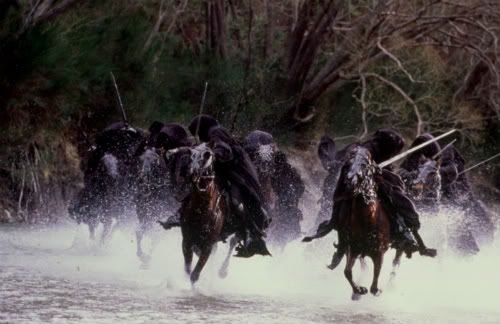In 1952, a committee was created called The Orange County Water Basin Conservation Committee. The name is misleading, because their purpose was not conservation in the traditional sense (i.e. limiting consumption or protecting the environment). Rather their purpose, according to Barbara Milkovich's History of Orange County Water District, "was raising funds for the purchase of outside water to replenish the underground basin," paving the way for future development and consumption. This committee, composed mainly of wealthy property owners "who wanted to be able to sell their land for the highest return" became known as The Committee of Twelve. I will refer to them hereafter as The Nazgul, or Ringwraiths.
The Nazgul realized that their best chance of finding "the precious" (i.e. higher property values) was to pool their vast political and financial resources. Politically conservative men like the Ringwraiths, good capitalists all, were not inclined to work together. However, as Milkovich notes, "Although Orange County leadership was politically cautious, it was profit-minded."
It was the Nazgul who created the bureaucracy necessary to insulate their interests from the general public. For example, in the cities of Anaheim, Fullerton, and Santa Ana, Water District Director positions were created. These directors were not elected by the people. Rather, they were appointed, knighted by the elite. This practice continues to this day. Fullerton, in particular, has a tradition of appointing, not electing, officials, like the police chief. This is known as oligarchy.
With their Director-puppets in place, the Nazgul fiercely protected their water rights, often using lawsuits and their powerful lobbying forces.
In the 1960s, according to Milkovich, "some people took a look at their environment and began to question whether they were really improving the quality of life by making substantial changes to the environment." These people, whom I will call The Fellowship, challenged the hegemony of the Nazgul and succeeded in protecting some rivers, with the passage of the Wild and Scenic Rivers Act in 1971.
But the power of the Nazgul could not be undone. Their power was now too interconnected with the political and municipal system. Despite small victories by the Fellowship, the Nazgul retained their power. Neither living nor dead, they could not be defeated. They had armies of bureaucrats, politicians, lawyers, and even scientists at their disposal. These were the orcs.
Using their dark arts (i.e. modern technology), the orcs built a facility wherein they could sell people's poop and pee back to them as drinking water. It was called "Water Factory 21," or "Mordor," a stinking cesspool of fire and filth.
One wonders just how long the Nazgul will maintain power. Is their power sustainable, given the limited supply of river and groundwater, or is this Shadow only a passing thing? Will a new day dawn?

